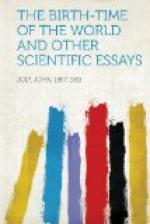26
atoms of lead and light atoms of uranium generating light atoms of lead. This assumption seems to be involved in the figures upon, which we are going. Still relying on these figures, we find, however, that existing uranium cannot give rise to lead of normal atomic weight. We can only conclude that the heavier atoms of uranium have decayed more rapidly than the lighter ones. In this connection it is of interest to note the complexity of uranium as recently established by Geiger, although in this case it is assumed that the shorter-lived isotope bears the relation of offspring to the longer-lived and largely preponderating constituent. However, there does not seem to be any direct proof of this as yet.
From these considerations it would seem that unless the atomic weight of lead in uraninites, etc., is 206, the former complexity and more accelerated decay of uranium are indicated in the data respecting the atomic weights of radium and lead[1]. As an alternative view, we may assume, as in our first hypothesis, that some elementally different but genetically connected substance, decaying along branching lines of descent at a rate sufficient to practically remove the whole of it during geological time, formerly existed. Whichever hypothesis we adopt
[1] Later investigation has shown that the atomic weight of lead in uranium-bearing ores is about 206.6 (see Richards and Lembert, Journ. of Am. Claem. Soc., July, 1914). This result gives support to the view expressed above.
27
we are confronted by probabilities which invalidate time-measurements based on the lead and helium ratio in minerals. We have, in short, grave reason to question the measure of uniformitarianism postulated in finding the age by any of the known radioactive methods.
That we have much to learn respecting our assumptions, whether we pursue the geological or the radioactive methods of approaching the age of our era, is, indeed, probable. Whatever the issue it is certain that the reconciling facts will leave us with much more light than we at present possess either as respects the Earth’s history or the history of the radioactive elements. With this necessary admission we leave our study of the Birth-Time of the World.
It has led us a long way from Lucretius. We do not ask if other Iliads have perished; or if poets before Homer have vainly sung, becoming a prey to all-consuming time. We move in a greater history, the landmarks of which are not the birth and death of kings and poets, but of species, genera, orders. And we set out these organic events not according to the passing generations of man, but over scores or hundreds of millions of years.
How much Lucretius has lost, and how much we have gained, is bound up with the question of the intrinsic value of knowledge and great ideas. Let us appraise knowledge as we would the Homeric poems, as some-




